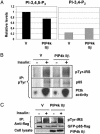The phosphatidylinositol (PI)-5-phosphate 4-kinase type II enzyme controls insulin signaling by regulating PI-3,4,5-trisphosphate degradation
- PMID: 12897244
- PMCID: PMC187868
- DOI: 10.1073/pnas.1734038100
The phosphatidylinositol (PI)-5-phosphate 4-kinase type II enzyme controls insulin signaling by regulating PI-3,4,5-trisphosphate degradation
Abstract
Phosphatidylinositol-5-phosphate (PI-5-P) is a newly identified phosphoinositide with characteristics of a signaling lipid but no known cellular function. PI-5-P levels are controlled by the type II PI-5-P 4-kinases (PIP4K IIs), a family of kinases that converts PI-5-P into phosphatidylinositol-4,5-bisphosphate (PI-4,5-P2). The PI-5-P pathway is an alternative route for PI-4,5-P2 synthesis as the bulk of this lipid is generated by the canonical pathway in which phosphatidylinositol-4-phosphate (PI-4-P) is the intermediate. Here we examined the effect of activation of the PI-5-P pathway on phosphoinositide 3-kinase (PI3K) signaling by expressing PIP4K II beta in cells that lack this enzyme. Although PIP4K II generates PI-4,5-P2, a substrate for PI3K, expression of this enzyme reduced rather than increased phosphatidylinositol-3,4,5-trisphosphate (PI-3,4,5-P3) levels in cells stimulated with insulin or cells expressing activated PI3K. This reduction in PI-3,4,5-P3 levels resulted in decreased activation of the downstream protein kinase, Akt/PKB. Consistent with these results, expression of IpgD, a bacterial phosphatase that converts PI-4,5-P2 to PI-5-P, resulted in Akt activation, and this effect was partially reversed by PIP4K II beta. PIP4K II beta expression did not impair insulin-dependent association of PI3K with insulin receptor substrate 1 (IRS1) but abbreviated Akt activation, indicating that PIP4K II regulates PI-3,4,5-P3 degradation rather than synthesis. These data support a model in which the PI-5-P pathway controls insulin signaling that leads to Akt activation by regulating a PI-3,4,5-P3 phosphatase.
Figures






Similar articles
-
A phosphatidylinositol 3-kinase/Akt/mTOR pathway mediates and PTEN antagonizes tumor necrosis factor inhibition of insulin signaling through insulin receptor substrate-1.Proc Natl Acad Sci U S A. 2001 Apr 10;98(8):4640-5. doi: 10.1073/pnas.051042298. Epub 2001 Apr 3. Proc Natl Acad Sci U S A. 2001. PMID: 11287630 Free PMC article.
-
SH2-containing inositol phosphatase 2 negatively regulates insulin-induced glycogen synthesis in L6 myotubes.Diabetologia. 2001 Oct;44(10):1258-67. doi: 10.1007/s001250100645. Diabetologia. 2001. PMID: 11692174
-
Phosphatidylinositol (3,4) bisphosphate-specific phosphatases and effector proteins: A distinct branch of PI3K signaling.Cell Signal. 2015 Sep;27(9):1789-98. doi: 10.1016/j.cellsig.2015.05.013. Epub 2015 May 27. Cell Signal. 2015. PMID: 26022180 Review.
-
Serum withdrawal-induced accumulation of phosphoinositide 3-kinase lipids in differentiating 3T3-L6 myoblasts: distinct roles for Ship2 and PTEN.Mol Cell Biol. 2007 Dec;27(23):8098-112. doi: 10.1128/MCB.00756-07. Epub 2007 Sep 24. Mol Cell Biol. 2007. PMID: 17893321 Free PMC article.
-
Regulation of PI3K effector signalling in cancer by the phosphoinositide phosphatases.Biosci Rep. 2017 Feb 10;37(1):BSR20160432. doi: 10.1042/BSR20160432. Print 2017 Feb 28. Biosci Rep. 2017. PMID: 28082369 Free PMC article. Review.
Cited by
-
An Emerging Role for PI5P in T Cell Biology.Front Immunol. 2013 Apr 2;4:80. doi: 10.3389/fimmu.2013.00080. eCollection 2013. Front Immunol. 2013. PMID: 23565114 Free PMC article.
-
Genetic association with overall survival of taxane-treated lung cancer patients - a genome-wide association study in human lymphoblastoid cell lines followed by a clinical association study.BMC Cancer. 2012 Sep 24;12:422. doi: 10.1186/1471-2407-12-422. BMC Cancer. 2012. PMID: 23006423 Free PMC article.
-
Phosphatidylinositol 3-kinase interacts with the glucocorticoid receptor upon TLR2 activation.J Cell Mol Med. 2011 Feb;15(2):339-49. doi: 10.1111/j.1582-4934.2009.00958.x. J Cell Mol Med. 2011. PMID: 19874421 Free PMC article.
-
PIP4Ks impact on PI3K, FOXP3, and UHRF1 signaling and modulate human regulatory T cell proliferation and immunosuppressive activity.Proc Natl Acad Sci U S A. 2021 Aug 3;118(31):e2010053118. doi: 10.1073/pnas.2010053118. Proc Natl Acad Sci U S A. 2021. PMID: 34312224 Free PMC article.
-
Phosphatidylinositol 3,5-bisphosphate: low abundance, high significance.Bioessays. 2014 Jan;36(1):52-64. doi: 10.1002/bies.201300012. Epub 2013 Oct 28. Bioessays. 2014. PMID: 24323921 Free PMC article. Review.
References
-
- Tengholm, A. & Meyer, T. (2002) Curr. Biol. 12, 1871–1876. - PubMed
-
- Toker, A. (1998) Curr. Opin. Cell Biol. 10, 254–261. - PubMed
-
- Fruman, D. A., Meyers, R. E. & Cantley, L. C. (1998) Annu. Rev. Biochem. 67, 481–507. - PubMed
-
- Ishihara, H., Shibasaki, Y., Kizuki, N., Wada, T., Yazaki, Y., Asano, T. & Oka, Y. (1998) J. Biol. Chem. 273, 8741–8748. - PubMed
Publication types
MeSH terms
Substances
Grants and funding
LinkOut - more resources
Full Text Sources
Other Literature Sources
Medical
Molecular Biology Databases
Research Materials
Miscellaneous

